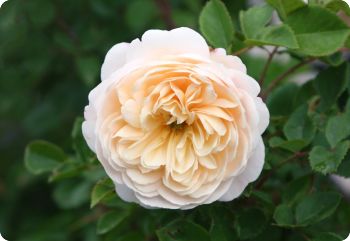Rose Fertilizer Recipe
by Diane Linsley
Growing roses organically is more effective, less complicated, and safer for both you and the environment. It's also safer for your cat. One year, my cat tried to sample my homemade rose fertilizer. Remembering the look on her face still makes me laugh! (Yes, cats do have looks on their faces.) She sat on the porch for fifteen minutes, trying to lick the smelly concoction off her face.
Before I reveal the secret recipe, I want to mention a couple more things that I put on my roses. In the spring, when the roses first start to leaf out, I push aside the wood-chip mulch and add a thin layer of compost or well-composted manure, mixed with a little bonemeal.
Another option is to apply 1/4 cup organic granular fertilizer around the root zone. Rake it into the top 2 inches of the soil using a hand-held cultivator. I've read that alfalfa pellets also make a good fertilizer. Scatter one handful around each rose. Now for the secret recipe. It's cheap, easy and fun!
Homemade Organic Rose Fertilizer
2 tablespoons Bio-Fish fertilizer
1 tablespoon Epsom salts
2 tablespoons apple cider vinegar
2 tablespoons molasses
3 cups water
Combine in a quart-size, liquid measuring cup. Stir with a wire whisk to remove the lumps. Pour into a 2-gallon watering can, and fill the can with water. This mixture makes a good foliar feed. You can pour the extra around the root zone.
It's best to apply it in the evening, since harsh afternoon sunlight might burn the leaves. Don't apply fertilizer to drought-stressed roses. They should be well-watered first. You might want to water in the fertilizer applied around the root zone, although this mixture is so mild that it won't harm the roots. One batch feeds 2-4 roses, depending on their size.
Since organic fertilizers work more slowly and steadily than chemical fertilizers, you don't have to worry about exact timing and measurements. I use this mixture in late spring to early summer, right before the roses begin blooming. It can be applied every 4-5 weeks throughout the growing season. Quit all fertilization at least 6 weeks before the first frost date in fall when the roses need to slow their growth in preparation for winter dormancy.
So, what do each of the ingredients do? Bio-Fish Fertilizer supplies the major nutrients needed for growth -- nitrogen, phosphorous and potassium, along with the trace minerals and natural plant hormones found in the kelp (one of the ingredients), which increase disease resistance and flowering.
The vinegar is added because we have alkaline soil. The acid in the vinegar helps the roses to absorb trace minerals. Epsom salts supply magnesium, which is especially needed in alkaline soils. Molasses provides iron, trace minerals, and a dose of sugar, which the roses use for a boost of energy during the bloom season.
The neatest thing about this recipe is that I can mix it up in my own kitchen. No toxins, no fears. Although my cat still comes around to take a sniff, she hasn't tried to taste it again!
Related Articles
Companion Plants for Roses - Annuals and perennials for the rose garden.
Fragrant Flowers - The most fragrant annual and perennial flowers from seed.
Cottage Garden Design - How to design a garden for year-round interest.
Recommended Resources
Peaceful Valley Farm Supply - Organic garden products. Bio-Fish Fertilizer.
Growing Roses Organically by Barbara Wilde
Heirloom Roses - My favorite source for own-root roses.
Seeds
